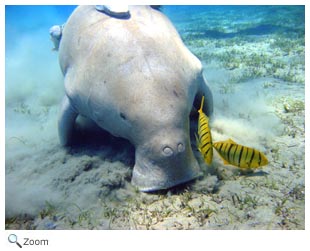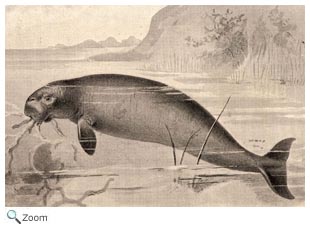Dugongidae -
dugongs
 There is one living species in this family. The dugong is found in warm, shallow coastal waters off of Africa, India, Australia, New
Guinea, and other South Pacific Islands. At 8-10 feet in length, it is the smallest member of the Sirenia order. There is one living species in this family. The dugong is found in warm, shallow coastal waters off of Africa, India, Australia, New
Guinea, and other South Pacific Islands. At 8-10 feet in length, it is the smallest member of the Sirenia order.
Dugongs have cleft lips; small eyes; dark, brownish-gray skin that is lightly covered with hair; paddle-like front flippers; and a tail with a dolphin-like fluke.
Dugongs eat sea grasses and algae. Females give birth to a single calf 12-14 months after mating. A calf may stay with its mother for up to six years. Dugongs can live to be 70 years old in the wild.
 Steller's sea cow is an extinct member of this family. It was once found in the North Pacific Ocean along the coasts of Alaska and Russia, and unlike other members of the Sirenia order, it thrived in cold waters. It was around 28 feet in length. It had no teeth and ate kelp and algae. Steller's sea cow is an extinct member of this family. It was once found in the North Pacific Ocean along the coasts of Alaska and Russia, and unlike other members of the Sirenia order, it thrived in cold waters. It was around 28 feet in length. It had no teeth and ate kelp and algae.
It was first reported by Georg Wilhelm Steller, a naturalist who was part of the crew of Vitus Bering 's ship the St. Peter. The St. Peter shipwrecked off the coast of Kamchatka in Russia in 1741. The crew killed six of the slow moving creatures for food to survive. The crew was able to leave in 1742 and reported what they had found when they returned home. Other crews returned hunted the sea cow and by 1768 it had been hunted to extinction.
World Status Key
 Least Concern Least Concern  Near Threatened Near Threatened  Vulnerable Vulnerable  Endangered Endangered  Critically Endangered Critically Endangered  Extinct in Wild Extinct in Wild  Extinct Extinct
Status and range is taken from ICUN Redlist. If no status is listed, there is not enough data to establish status.
US Status Key
 Threatened in US Threatened in US  Threatened in NH Threatened in NH  Endangered in US Endangered in US  Endangered in NH Endangered in NH  Introduced Introduced
Status taken from US Fish and Wildlife and NH Fish and Game
New Hampshire Species |
|
North/Central American Species |
| None |
|
Steller's Sea Cow - Hydrodamalis gigas  |
Additional Information
Key:  Profile Profile  Photos Photos  Video Video  Audio Audio
Dugong - Dugong dugon       
The dugong is rarely found in fresh water.
Source: Arkive Intended Audience: General Reading Level: Middle School
Dugong - Dugong dugon       
Dugongs communicate underwater using chirps, whistles, and barks.
Source: Animal Diversity Web Intended Audience: General Reading Level: Middle School |


